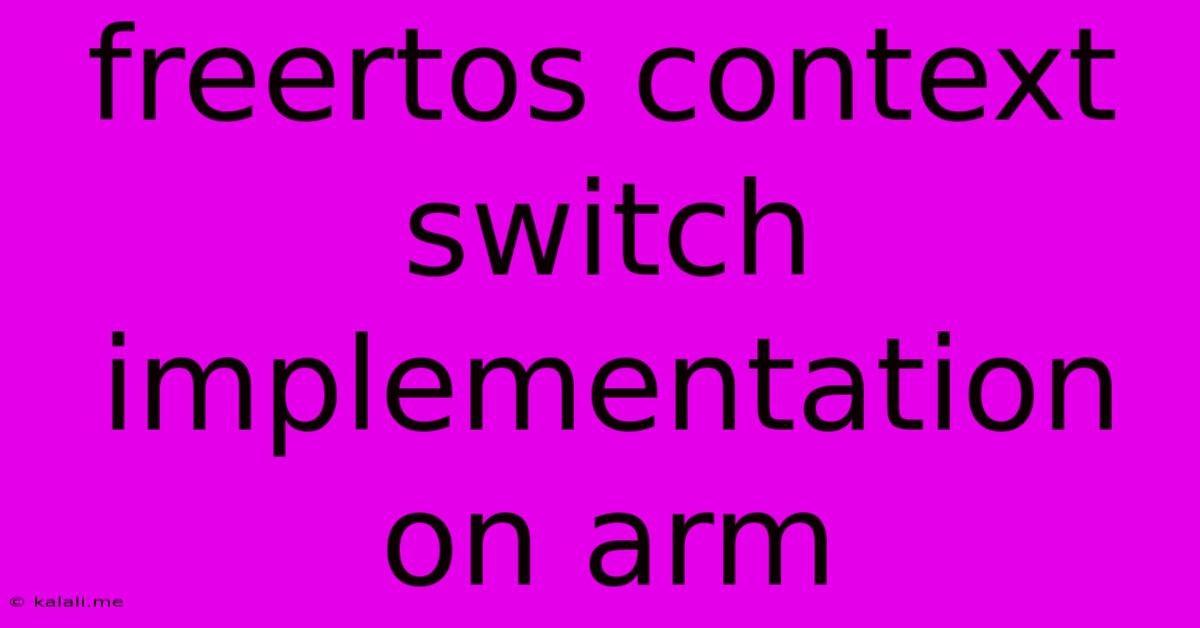Freertos Context Switch Implementation On Arm
Kalali
Jun 07, 2025 · 4 min read

Table of Contents
FreeRTOS Context Switch Implementation on ARM: A Deep Dive
Meta Description: Understand the intricacies of FreeRTOS context switching on ARM architectures. This article delves into the process, code analysis, and optimization techniques for efficient multitasking. Learn about the critical role of the ARM processor's exception handling mechanism and the implications for real-time systems.
FreeRTOS, a widely adopted real-time operating system (RTOS), relies heavily on context switching to manage multiple tasks concurrently. This process, crucial for multitasking, involves saving the current task's state and restoring the state of a different task, creating the illusion of parallel execution. On ARM architectures, this implementation leverages the processor's exception handling mechanism, providing a robust and efficient way to manage task transitions. This article explores the core mechanisms behind FreeRTOS context switching on ARM, focusing on the critical steps and optimizations involved.
Understanding the Context Switching Process
At the heart of FreeRTOS lies the scheduler, responsible for selecting the next task to run. When a context switch occurs, several key steps are executed:
-
Saving the Current Task's Context: This involves preserving the processor's registers, including the program counter (PC), stack pointer (SP), and any other relevant registers specific to the ARM architecture used. This information represents the current task's execution state. The specific registers saved depend on the ARM architecture variant (e.g., Cortex-M, Cortex-A).
-
Selecting the Next Task: The FreeRTOS scheduler uses a priority-based algorithm (or round-robin for tasks of equal priority) to choose the highest-priority ready task. This selection often involves traversing a task list, determining readiness, and identifying the next task to execute.
-
Restoring the Next Task's Context: The saved context of the selected task is then loaded back into the processor's registers. This effectively resumes the execution of that task from where it left off.
-
Returning to the Task: The processor resumes execution at the instruction pointed to by the restored program counter, effectively switching the control flow to the newly selected task.
The Role of ARM Exceptions
ARM processors utilize exceptions (interrupts) for various events, including context switching. FreeRTOS cleverly uses the exception mechanism to trigger context switches efficiently. When a task's time slice expires, or another event warrants a switch, an interrupt is generated. This interrupt handler then initiates the context switching sequence as described above. This approach minimizes the overhead associated with context switching compared to other methods.
Critical Sections and Context Switching
The integrity of shared resources necessitates protection through critical sections. When a task enters a critical section, interrupts are often disabled to prevent preemption and race conditions. However, this prevents context switches from occurring during the critical section. Careful design of critical sections is vital to avoid introducing unnecessary delays. FreeRTOS provides mechanisms like mutexes and semaphores to manage access to shared resources efficiently.
Optimizing Context Switch Overhead
Minimizing context switch overhead is crucial for real-time applications. Several optimization techniques can be employed:
-
Register Usage: Efficient usage of processor registers reduces the number of memory accesses during context saving and restoring, enhancing performance.
-
Stack Management: Optimizing stack usage reduces the time required for stack pointer manipulation during context switching.
-
Cache Management: For ARM architectures with caches, careful management of the cache can reduce memory access latency.
-
Compiler Optimization: Employing appropriate compiler optimization flags can improve the efficiency of the context switching code.
Analyzing the FreeRTOS Context Switch Code (Conceptual Overview)
While the specific implementation details vary based on the ARM architecture and FreeRTOS version, the core components remain consistent. The portSAVE_CONTEXT() and portRESTORE_CONTEXT() functions are central to this process, handling the saving and restoring of processor registers. These functions are highly architecture-specific and are typically provided by the FreeRTOS port for the specific ARM microcontroller. These functions interact with the scheduler's task management functions to achieve the seamless transition between tasks.
Conclusion
Understanding the context switching mechanism within FreeRTOS on ARM is essential for developing efficient and reliable real-time embedded systems. By understanding the interplay between the ARM architecture's exception handling, the FreeRTOS scheduler, and the optimization techniques available, developers can create systems that meet stringent timing constraints and deliver high performance. This knowledge is crucial for optimizing resource utilization and maximizing the responsiveness of the application.
Latest Posts
Latest Posts
-
Beauty And The Beast Prince Adam
Jun 07, 2025
-
How Long Does Rokokos Retargeting Take
Jun 07, 2025
-
Are Bolted Connections Fixed Or Pinned
Jun 07, 2025
-
How To Take Out A Broken Screw Head
Jun 07, 2025
-
What Angle To Join 3 Right Isosceles Triangles
Jun 07, 2025
Related Post
Thank you for visiting our website which covers about Freertos Context Switch Implementation On Arm . We hope the information provided has been useful to you. Feel free to contact us if you have any questions or need further assistance. See you next time and don't miss to bookmark.